Ford Explorer: Installing Child Restraints / Using Lap and Shoulder Belts
WARNING: Do not place a rearward facing child restraint in front of an active airbag. Failure to follow this instruction could result in personal injury or death.
WARNING: Properly secure children 12 years old and under in a rear seating position whenever possible. If you are unable to properly secure all children in a rear seating position, properly secure the largest child on the front seat. If you must use a forward facing child restraint on the front seat, move the seat as far back as possible. Failure to follow these instructions could result in personal injury or death.
WARNING: Depending on where you secure a child restraint, and depending on the child restraint design, you may block access to certain seatbelt buckle assemblies and LATCH lower anchors, rendering those features potentially unusable. To avoid risk of injury, make sure occupants only use seating positions where they are able to be properly restrained.
When installing a child restraint with combination lap and shoulder belts:
- Use the correct seatbelt buckle for that seating position.
- Insert the belt tongue into the proper buckle until you hear a snap and feel it latch. Make sure the tongue is securely fastened in the buckle.
- Keep the buckle release button pointing up and away from the child restraint, with the tongue between the child restraint and the release button, to prevent accidental unbuckling.
- Place the vehicle seat in the upright position before you install the child restraint.
- For second row seating positions, adjust the recliner slightly to improve child restraint fit. If needed, remove the head restraints.
- For third row seating positions, stow the head restraints to improve child restraint fit. See Head Restraints.
- Put the seatbelt in the automatic locking mode. See Step 5 in the procedure that follows. This vehicle does not require the use of a locking clip.
- Perform the following steps when installing the child restraint with combination lap and shoulder belts:
Note: Although the child restraint illustrated is a forward facing child restraint, the steps are the same for installing a rear facing child restraint.
Note: Follow all instructions provided by the manufacturer of the child restraint regarding the necessary and proper use of the lock-off device. In some instances, the manufacturer provides these devices only for use in vehicles with seatbelt systems that would otherwise require a locking clip.
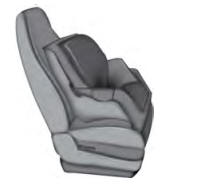
- Position the child restraint in a seat with a combination lap and shoulder
belt.
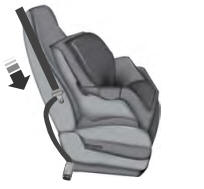
- After positioning the child restraint in the proper seating position, pull
down on the shoulder belt and then grasp the shoulder belt and lap belt together
behind the belt tongue.
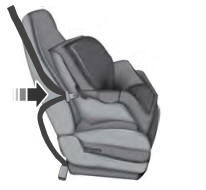
- While holding the shoulder and lap belt portions together, route the tongue
through the child restraint according to the child restraint manufacturer's
instructions. Make sure you do not twist the belt webbing.
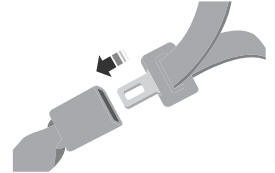
- Insert the belt tongue into the proper buckle (the buckle closest to the
direction the tongue is coming from) for that seating position until you hear
a snap and feel the latch engage. Make sure that you securely latch the tongue
by pulling on it.
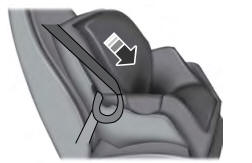
- To put the retractor in the automatic locking mode, grasp the shoulder portion
of the belt and pull downward until you pull all of the belt out.
Note: The automatic locking mode is available on the front passenger and rear seats.
- Allow the belt to retract to remove slack. The belt clicks as it retracts to indicate it is in the automatic locking mode.
- Try to pull the belt out of the retractor to make sure the retractor is
in the automatic locking mode. You should not be able to pull more belt out.
If the retractor did not lock, unbuckle the belt and repeat Steps 5 and 6.
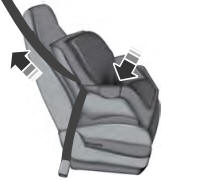
- Remove remaining slack from the belt. Force the seat down with extra weight, for example, by pressing down or kneeling on the child restraint as you pull up on the shoulder belt to force slack from the belt. This is necessary to remove the remaining slack that exists once you add the extra weight of the child to the child restraint. It also helps to achieve the proper snugness of the child restraint to your vehicle. Sometimes, a slight lean toward the buckle provides extra help to remove remaining slack from the belt.
- If the child restraint has a tether strap, attach it now.
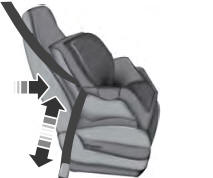
- Before placing the child in the seat, forcibly move the seat forward and back to make sure you have the seat securely held in place. To check this, grab the seat at the belt path and attempt to move it side to side and forward and back. There should be no more than 1 in (2.5 cm) of movement for proper installation.
We recommend checking with a NHTSA Certified Child Passenger Safety Technician to make sure you properly installed the child restraint. In Canada, check with Transport Canada for referral to a Child Car Seat Clinic.
 Child Seats
Child Seats
Use a child restraint (sometimes called an infant carrier, convertible seat,
or toddler seat) for Infants, toddlers and children weighing 40 lb (18 kg) or less
(generally four-years-old or youn..
 Using Lower Anchors and Tethers for CHildren (LATCH)
Using Lower Anchors and Tethers for CHildren (LATCH)
WARNING: Do not attach two child safety restraints to the same anchor.
In a crash, one anchor may not be strong enough to hold two child safety restraint
attachments and may break, causing serious..
Other information:
Ford Explorer 2020-2025 Service Manual: General Procedures - Transmission Fluid Level Check
Check NOTICE: The vehicle should not be driven if the transmission fluid level is low. Internal failure could result. NOTE: If the vehicle has been operated for an extended period at high highway speeds, in city traffic, during hot weather or while pulling a trailer, the transmission fluid must cool down to obtain an accurate reading...
Ford Explorer 2020-2025 Service Manual: Removal and Installation - Park Lock Pawl Solenoid
Removal Remove the transmission fluid pan, gasket and filter. Refer to: Transmission Fluid Pan, Gasket and Filter (307-01C Automatic Transmission - 10-Speed Automatic Transmission – 10R80 MHT, Removal and Installation). Slide the plastic lock to the unlock position...
Categories
- Manuals Home
- 6th Generation Explorer Owners Manual
- 6th Generation Explorer Service Manual
- General Procedures - Transmission Fluid Drain and Refill
- Electric Parking Brake
- Automatic Transmission - 10-Speed Automatic Transmission – 10R60
- New on site
- Most important about car
Windshield Wipers
 Push the lever up or down to operate
the windshield wipers.
Push the lever up or down to operate
the windshield wipers.
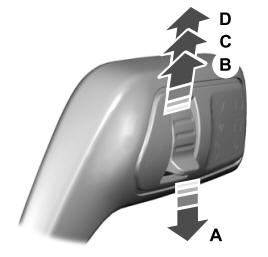
A - Single wipe.
